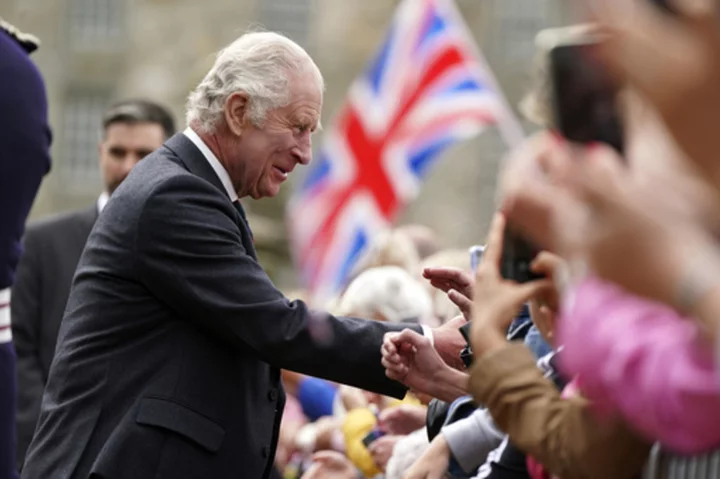LONDON (AP) — Two months after the lavish coronation of King Charles III at Westminster Abbey in London, Scotland is set to host its own event to mark the new monarch’s accession to the throne.
While Charles and Queen Camilla won’t be crowned a second time Wednesday in Edinburgh, the festivities will include a crown, horse-drawn carriages, mounted cavalry and a flyover by the Red Arrows, the Royal Air Force’s aerobatic display team, as Scotland celebrates its unique relationship with the monarchy.
The focal point of the event is a service of thanksgiving at St. Giles’ Cathedral, where Charles will be presented with the Scottish Honors — the crown, scepter and sword of state once used to crown Scotland’s kings and queens. The Stone of Destiny, an important symbol of Scottish identity, will also be moved to the cathedral for the festivities.
The presence of these icons of Scotland’s nationhood is a mark of respect for a country that is fiercely proud of its history and where the desire of some for independence has never died, even though it has been bound to England and the United Kingdom since 1707. Scotland’s national government is led by the Scottish National Party, which is calling for a second independence referendum.
“It’s not a coronation,’’ said George Gross, an expert in coronations at King’s College London. ‘’But it’s very symbolic in that Scotland has its own identity.’’
Wednesday’s events in Edinburgh are a continuation of Charles’ effort to cement ties with the people of the four nations that make up the United Kingdom as he tries to show that the 1,000-year-old monarchy remains relevant in modern Britain. Soon after the death of his mother, Queen Elizabeth II, last September, Charles visited Northern Ireland, Scotland and Wales before attending the state funeral in London.
Just as May’s coronation ceremony gave nods to the multicultural nature of Britain today, Wednesday’s church service will include a psalm sung in Gaelic. Charles will also be presented with a new sword made by Scottish artisans and named after Elizabeth. The sword will be used in place of the current sword of state, which was made in 1507 and is too fragile for use in the ceremony.
But some Scots won’t be celebrating as people throughout the U.K. face a cost-of-living crisis fueled by high food and energy costs.
The group, Our Republic, which campaigns for an elected head of state in Scotland, has scheduled a protest rally outside the Scottish parliament to coincide with the coronation events.
“The vast majority of Scotland didn’t care to celebrate the coronation in May, with support for the monarchy at an all-time low in Scotland,” the group said in a statement. “Charles’ perpetual need to celebrate his reign, with all the pomp and pageantry it requires, is a spit in the face to the people struggling with the cost of living.”
The coronation festivities will begin in the early afternoon with a People’s Procession that will travel down the Royal Mile from Edinburgh Castle to St. Giles’ Cathedral. The procession will include more than 100 people representing charities and public service groups such the Scottish Ambulance Service, the Royal Scottish Highland Games Association and the Girls’ Brigade.
The Scottish Honors will follow behind escorted by police and military units.
Soon after, the Household Cavalry Mounted Regiments and a collection of military bands will set off from the Palace of Holyroodhouse, the king’s official residence in Edinburgh. Charles and Camilla will then leave the palace.
The one-hour service of thanksgiving is scheduled to start at 2:15 p.m. (13:15 GMT) It will be followed by a 21-gun salute and the Red Arrows flyover.
The festivities will provide an opportunity for royal fans to celebrate Charles’ coronation while also paying homage to Scotland’s unique history.
Historically an independent country, Scotland was first linked to England in 1603 after the death of Queen Elizabeth I. Because the queen had no children, the crown passed to her cousin James VI who was already king of Scotland, uniting the two countries under a shared sovereign.
But Scotland remained independent until 1707 when lawmakers in both countries approved the Act of Union, which created the United Kingdom.
The public festivities are likely to be personally moving for Charles, who will stand on roughly the same spot where he stood vigil last year, watching over his mother’s coffin with the crown of Scotland resting on its lid.
“I think it would be extraordinary if that didn’t have an impact on him or on any human being,” said Gross, a visiting research fellow in theology at King’s College London.
“It’s very important in bringing the union together, just as after his mother died, after the late queen died, he did various services around the Union, Wales, Northern Ireland, Scotland, so on. So he will be doing the same here. This is bringing things together.”
___
See more AP coverage of the British monarch at https://apnews.com/hub/king-charles-iii

